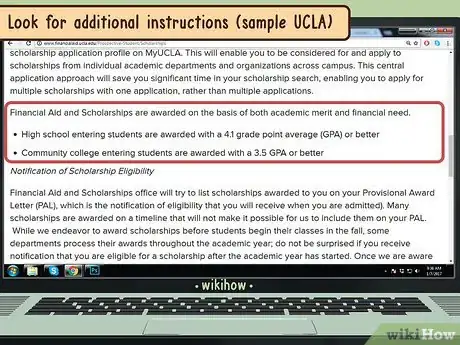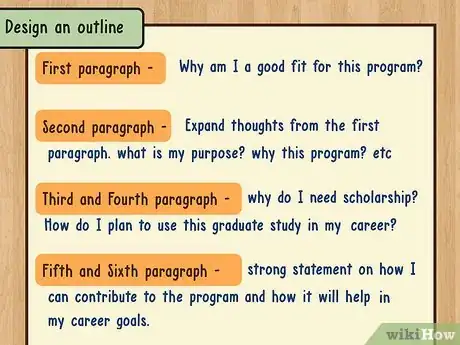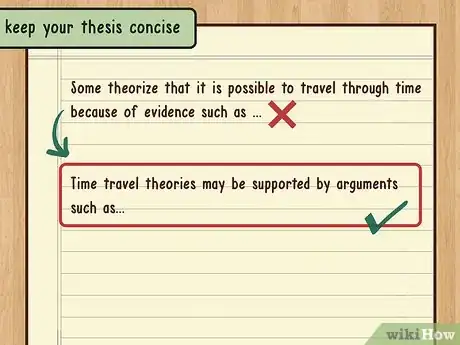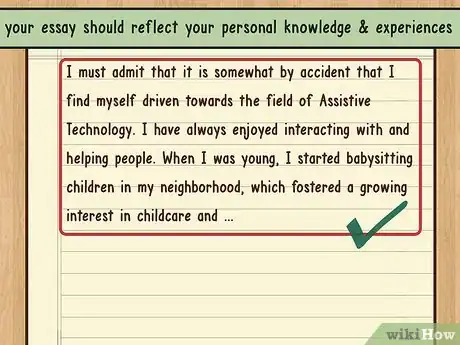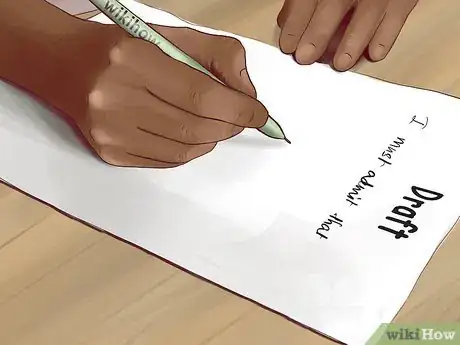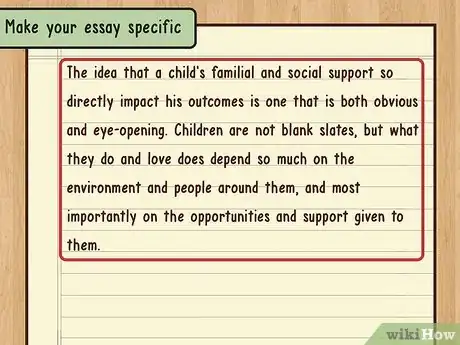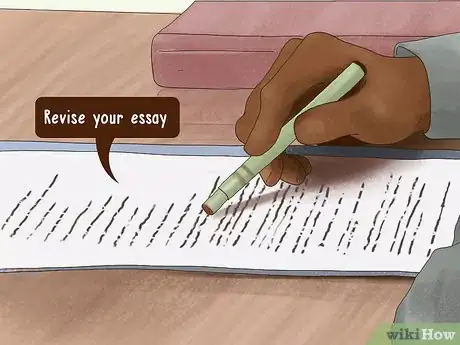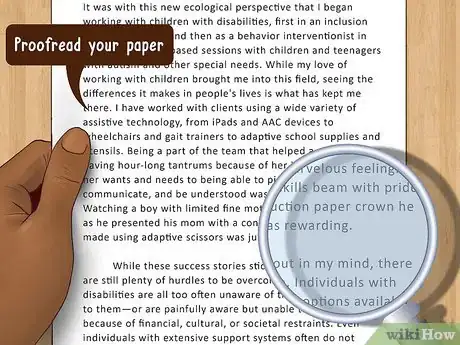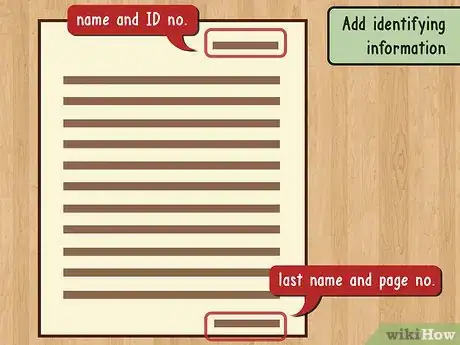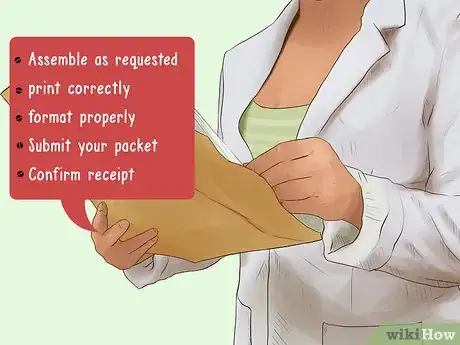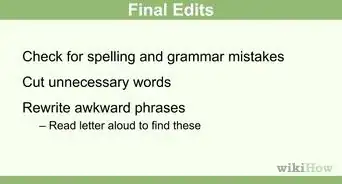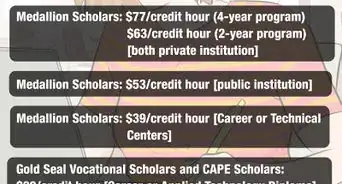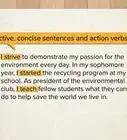This article was co-authored by Alexander Ruiz, M.Ed.. Alexander Ruiz is an Educational Consultant and the Educational Director of Link Educational Institute, a tutoring business based in Claremont, California that provides customizable educational plans, subject and test prep tutoring, and college application consulting. With over a decade and a half of experience in the education industry, Alexander coaches students to increase their self-awareness and emotional intelligence while achieving skills and the goal of achieving skills and higher education. He holds a BA in Psychology from Florida International University and an MA in Education from Georgia Southern University.
There are 11 references cited in this article, which can be found at the bottom of the page.
This article has been viewed 128,250 times.
Applying for scholarships is a common experience for many college-level students. However, some students may get overwhelmed when they learn scholarships require personal statements or essays in response to a specific prompt. Scholarship essays are a critical part of applying for funding, as they give the scholarship committee an idea of how an applicant relates to their organization and the goals of their scholarship. A strong essay can help an applicant stand out from a pool of people with similar credentials. All it takes is a little bit of time to plan the essay in advance, and a critical eye for revisions.
Steps
Planning Your Essay
-
1Read the prompt. Many scholarships require applicants to submit an essay on a certain prompt or topic. Carefully read your prompt to understand what your essay’s subject should be before you start writing.[1]
- Prompts may also give you guidelines regarding things like essay length or word count. Check carefully to see if your prompt specifies things like, “Write 500 words on the topic,” or, “Write two to three pages.”
-
2Look for additional instructions. Before you start writing your essay, check the scholarship’s rules and guidelines for additional instructions that may not be in the prompt. Read carefully to make sure you understand what kind of formatting is required, when the scholarship due date is, what kinds of students may qualify for the scholarship, and what, if anything else, you need to submit with your essay.
- Check the web page for the scholarship or the group or organization offering it to find additional rules and regulations.
- If something is not specified by the scholarship provider, such as the length of your submission or the due date, contact the providing organization and ask, “What are the guidelines for this scholarship?”
Advertisement -
3Brainstorm a few ideas. No matter what prompt you get, there will be more than one way to answer it. Start by brainstorming a few ideas. Don’t immediately get to work on the first idea that comes to mind. Instead, consider multiple perspectives and ways to answer the question.[2]
- Your first idea may still provide for the most cohesive essay, but brainstorming multiple ideas helps you think outside the box and consider multiple facets of the prompt.
- Jot down your ideas in no more than a few sentences. If you can, give yourself a full day and night to clear your head, then come back and review your ideas with fresh eyes.
- When reviewing your ideas, try to avoid obvious answers. If, for example, the prompt is to write about someone you admire, avoid talking about the President or a well-know philanthropist. Turn instead to your own experiences to make your essay unique.
-
4Outline your essay. Once you have a topic, outline key points of your essay before you start a full written draft. This helps you get down key ideas and concepts beforehand so that you don’t forget them while you write.[3]
- Make each important concept it's own heading, then add two to three points under it supporting your core point or idea.
- If you don’t like traditional outlines, you may want to try flowcharts, thought webs, or other forms of visual organization to show how your ideas relate.
- Don't feel like you must write your essay in the traditional five-paragraph format. You want to share and tell your story in the way that will be most attractive to others.[4]
Drafting Your Essay
-
1Create a thesis. Depending upon the length of your essay, this may be as simple as a topic sentence, or it may take multiple paragraphs. Regardless, your thesis should communicate the core concept that holds your essay together. All the concepts that you mention in your essay should relate back to your thesis.
- Try to keep your thesis as concise as possible. Worry less about fitting in big vocabulary words and more about making your point clearly and meaningfully in as few words as possible.[5]
- For example, “Some theorize that it is possible to travel through time because of evidence such as,” may be shortened to, “Time travel theories may be supported by arguments such as.”
-
2Write what you know. No matter what your essay prompt, your essay should reflect your personal knowledge and experiences. Write about something about which you are passionate, and make your essay personal and relatable.[6]
- If your prompt asks you directly about personal ambitions or experience, don’t just provide a synthesis of what you have done. Also touch on why your schoolwork and extracurricular activities are important to you.
- Make your essay stand out by talking about why your experience is personally significant.
- If your prompt does not deal directly with personal experience, still find a way to talk about why the topic you choose to address is significant and meaningful.
-
3Start with a rough draft. Whether you want to call it a first draft or a trial essay, work up an initial draft for you to review and consider. Leave yourself time to write a complete essay and revise it several times before it needs to be submitted.
- Use your first draft as an opportunity to get down all of your points and ideas. Do not worry so much about flow or formatting. Start by ensuring the content is present.
- If possible, give yourself a day or two between writing your first draft and revising your essay. This way, you are more likely to catch errors with grammar and formatting.[7]
-
4Make your essay specific. Make your scholarship application essay specific to your audience. Each scholarship is going to want something different, and every scholarship organization will stand for something different. Write an essay unique to your reader.
- This means avoiding trying to write a general essay that you can use for all application. Take the time to customize your essay to fit each scholarship, because even if both ask, "What was an experience that changed your life?" an academic and a community service scholarship are going to expect two different kinds of answers.
-
5Revise your essay. Once you have taken some time away, reread your essay with a critical eye toward content and logical flow. Now that all of your concepts are together on the page, rework your essay into a logical format and edit the content to be as clear and concise as possible.
- Try reading your essay out loud to yourself. Listen closely to what you are saying to see if it makes sense.[8]
- Trying working from a print-off if possible, alongside a computer screen. This way, you can make notes and edits on your paper before changing everything in your text document.
Finalizing Your Essay
-
1Proofread your paper. After you have a revised draft of your essay that you are happy with, proofread your paper one more time, this time looking specifically for spelling and grammar errors. Go line by line to check for issues with spelling, grammar, formatting, or anything that may have failed to grab your eye in earlier drafts.[9]
- Try working one line at a time and covering up the rest of your essay with a blank sheet of paper to focus your attention on what you are editing at that moment.
- Do not rely on computer spelling and grammar checks, as they often miss common mistakes such as homophones and alternating verb tenses.
-
2Find an editor. No matter how thoroughly you edit, it always helps to have another person look over your essay. Find a peer, a friend, or a family member and ask them, “Would you be willing to read and help me revise my scholarship essay?”[10]
- Ask someone you know has a strong command of the written word. They should be able to identify common spelling and grammar mistakes, as well as reading for the overall flow of the essay.
- Let your editor see the prompt, as well as your essay, so that they can understand how clearly and completely you address your essay topic.
-
3Add identifying information. Even if you submit your essay with a cover sheet or application sheet, be sure to include identifying information such as your name and your ID number, if applicable, at the top of your essay. This ensures that it can be reunited with the rest of your application if it gets separated at any point.[11]
- If your essay is more than one page, add your last name and page number to the header or footer of each page.
-
4Submit your packet. Assemble your application including your essay in the format requested by the scholarship committee. If you are sending in a print application, make sure your essay printed correctly and is properly formatted on the page. If you are submitting electronically, pay attention to what type of documents, such as Microsoft Word files or PDFs, may be uploaded with your application.
- Confirm receipt of your application if you don't get one electronically. Call into the scholarship office and ensure that your application, including your essay, has been received.
Expert Q&A
Did you know you can get expert answers for this article?
Unlock expert answers by supporting wikiHow
-
QuestionHow do you write a scholarship statement?
 Alexander Ruiz, M.Ed.Alexander Ruiz is an Educational Consultant and the Educational Director of Link Educational Institute, a tutoring business based in Claremont, California that provides customizable educational plans, subject and test prep tutoring, and college application consulting. With over a decade and a half of experience in the education industry, Alexander coaches students to increase their self-awareness and emotional intelligence while achieving skills and the goal of achieving skills and higher education. He holds a BA in Psychology from Florida International University and an MA in Education from Georgia Southern University.
Alexander Ruiz, M.Ed.Alexander Ruiz is an Educational Consultant and the Educational Director of Link Educational Institute, a tutoring business based in Claremont, California that provides customizable educational plans, subject and test prep tutoring, and college application consulting. With over a decade and a half of experience in the education industry, Alexander coaches students to increase their self-awareness and emotional intelligence while achieving skills and the goal of achieving skills and higher education. He holds a BA in Psychology from Florida International University and an MA in Education from Georgia Southern University.
Educational Consultant
-
QuestionHow do you begin a personal statement?
 Alexander Ruiz, M.Ed.Alexander Ruiz is an Educational Consultant and the Educational Director of Link Educational Institute, a tutoring business based in Claremont, California that provides customizable educational plans, subject and test prep tutoring, and college application consulting. With over a decade and a half of experience in the education industry, Alexander coaches students to increase their self-awareness and emotional intelligence while achieving skills and the goal of achieving skills and higher education. He holds a BA in Psychology from Florida International University and an MA in Education from Georgia Southern University.
Alexander Ruiz, M.Ed.Alexander Ruiz is an Educational Consultant and the Educational Director of Link Educational Institute, a tutoring business based in Claremont, California that provides customizable educational plans, subject and test prep tutoring, and college application consulting. With over a decade and a half of experience in the education industry, Alexander coaches students to increase their self-awareness and emotional intelligence while achieving skills and the goal of achieving skills and higher education. He holds a BA in Psychology from Florida International University and an MA in Education from Georgia Southern University.
Educational Consultant Try making a resume or brag sheet of all your experiences, and think about when they started, finished, what your accomplishments were during that experience, your tasks and responsibilities, and some of the successes and challenges you faced. By reflecting on your experiences, you're giving yourself lots of material to write about!
Try making a resume or brag sheet of all your experiences, and think about when they started, finished, what your accomplishments were during that experience, your tasks and responsibilities, and some of the successes and challenges you faced. By reflecting on your experiences, you're giving yourself lots of material to write about! -
QuestionWhat type of personal qualifications should I include?
 Brian Salazar-PrinceTop AnswererIn a scholarship statement it is important to highlight your positive attributes and, if possible, to provide examples. You should discuss hardships and challenges you have overcome and, if there are any issues in your academic performance (maybe a semester of lower grades), you'll want to explain that in a way that doesn't make excuses but helps to better understand what happened and why it won't happen again. Most scholarships also consider community involvement and service, so if you are employed, have a child, or participate in school clubs or groups, sports, or community volunteer work, that should be included, as well.
Brian Salazar-PrinceTop AnswererIn a scholarship statement it is important to highlight your positive attributes and, if possible, to provide examples. You should discuss hardships and challenges you have overcome and, if there are any issues in your academic performance (maybe a semester of lower grades), you'll want to explain that in a way that doesn't make excuses but helps to better understand what happened and why it won't happen again. Most scholarships also consider community involvement and service, so if you are employed, have a child, or participate in school clubs or groups, sports, or community volunteer work, that should be included, as well.
Warnings
- Do not repeat information that is located elsewhere within your application. Your essay should be comprised of personal information that you decide to provide.⧼thumbs_response⧽
References
- ↑ http://www.studentscholarshipsearch.com/tips/scholarship-essay-tips.php
- ↑ http://www.inc.com/john-boitnott/10-longtime-brainstorming-techniques-that-still-work.html
- ↑ https://www.estrellamountain.edu/students/scholarships/essay
- ↑ Alexander Ruiz, M.Ed.. Educational Consultant. Expert Interview. 18 June 2020.
- ↑ http://www.howtowriteclearly.co.uk/how-to-write-an-A-grade-college-essay-5.html
- ↑ http://www.usnews.com/education/blogs/the-scholarship-coach/2013/01/31/4-ways-to-make-your-scholarship-essay-stand-out
- ↑ http://writingcenter.unc.edu/handouts/editing-and-proofreading/
- ↑ http://writing.wisc.edu/Handbook/Proofreading.html
- ↑ https://owl.english.purdue.edu/owl/resource/561/01/
About This Article
If you need to write a personal statement for a scholarship, carefully read the scholarship application to see if there is a particular subject or prompt you should follow. Once you know the topic for your statement, write about why you are interested in your field of study, how the scholarship will help you achieve your goals, and what you think you can bring to the program. In addition, you should make the essay specific to the particular scholarship you are applying for. For tips on finding someone to proofread your scholarship essay, keep reading!

